Introduction
In a world where workplace wellness is becoming increasingly essential, prioritizing core strength can serve as a powerful catalyst for overall health and productivity. A strong core is not merely about aesthetics; it lays the groundwork for improved posture, reduced back pain, and enhanced athletic performance.
By integrating a daily core routine into the lives of team members, organizations can foster a culture of well-being that transcends the office walls. With the right tools and support, such as personalized coaching and innovative wellness programs, employees can embark on a transformative journey toward better health.
This article delves into the significance of core strength, offers a step-by-step guide to building an effective routine, and presents strategies to maintain motivation, all while seamlessly incorporating core exercises into the workday. Embracing these practices not only benefits individual health but also cultivates a more engaged and productive workforce.
The Importance of a Daily Core Routine
Incorporating a daily core routine is crucial for fostering overall health and enhancing performance in both professional and personal activities. Core strength extends far beyond the aesthetic of visible abs; it serves as the foundation for stabilizing the entire body. A strong foundation is instrumental in improving posture, which can alleviate back pain—a prevalent concern in sedentary occupations.
Furthermore, our wellness coaching app offers personalized workouts, guided nutrition, and daily programming to support your team in achieving their health goals efficiently. With access to a 350+ movement catalog, bi-weekly group calls, and an accountability and data hub, users can tailor their fitness journey to their specific needs. Research shows that fundamental strength significantly improves athletic performance, resulting in better balance and stability.
For example, studies on teenage male handball athletes indicated a significant impact on balance and a moderate enhancement in vertical jump height, highlighting the significance of strength training for the torso. Furthermore, a well-developed center significantly reduces the risk of injuries, especially in the lower back, making it crucial for anyone looking to maintain an active lifestyle. By committing to a daily core routine, which is supported by our app's features like direct messaging with coaches and community engagement, your team is not merely working on their physical appearance; they are investing in their overall well-being and boosting productivity in the workplace.
A case study utilizing the Humac Norm Balance System assessed balance performance, providing real-world evidence of the advantages of fundamental training. As noted by Weimar, 'The central muscles are important because they stabilize the center of the body so that the muscles of the appendicular skeleton can pull against a stable platform.' This investment not only pays off in health benefits but also translates into tangible improvements in workplace performance.
Furthermore, taking into account the MIND diet's connection to improved memory and cognitive abilities, incorporating foundational strength activities through our app can additionally boost overall health, creating a holistic approach to well-being.
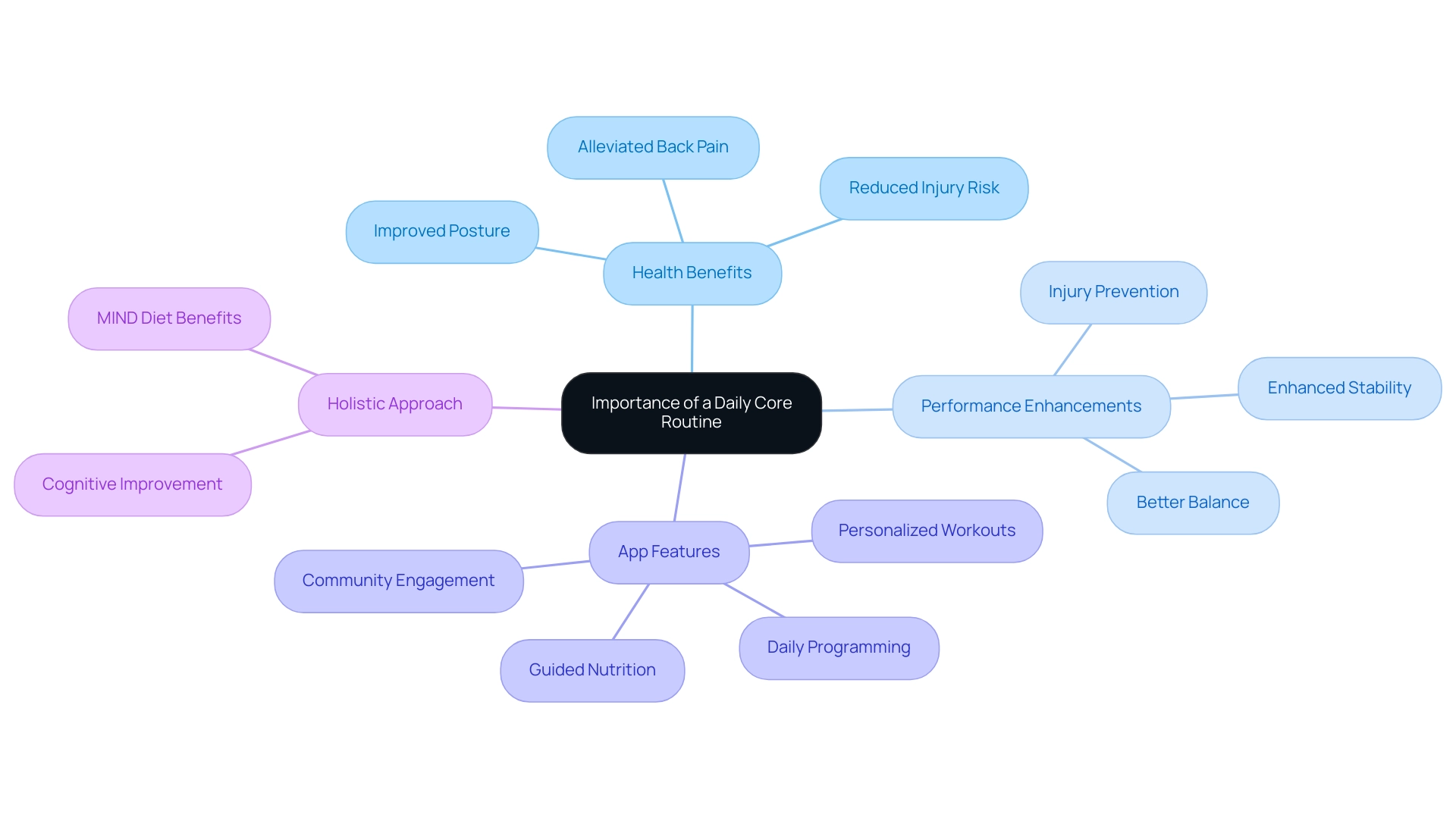
Step-by-Step Guide to Building Your Core Routine
Establishing a daily core routine is both empowering and essential for enhancing overall fitness. Research by Weston et al. (2013) involving 36 participants emphasizes the effectiveness of foundational workouts in enhancing stability and strength.
Follow these steps to embark on your journey toward core strength:
- Warm-Up: Start with a 5-10 minute warm-up to prepare your muscles for action. Engaging in activities like light jogging, jumping jacks, or dynamic stretches increases blood flow and flexibility, setting the stage for a successful workout.
- Plank: Begin with the plank position, holding for 20-30 seconds. This essential routine engages various central muscles and enhances stamina. As you grow stronger, challenge yourself by gradually increasing the duration of your hold. As Fletcher & Bagley observed, a notable rise in ES activation is linked to appropriate physical activity performance, which is essential for stability in the center.
- Russian Twists: Sit on the floor with your knees bent, leaning back slightly. Grasp a weight or even a water bottle, and twist your torso to the right, then to the left. Aim for 10-15 repetitions on each side. This activity is recommended in recent studies for its effectiveness in enhancing rotational stability.
- Bicycle Crunches: Lie flat on your back and lift your legs to a 90-degree angle. Bring your opposite elbow to your knee while extending the other leg. Alternate sides for 10-15 repetitions. This dynamic movement not only involves the central muscles but also enhances coordination.
- Leg Raises: Position yourself flat on your back with legs straight. Lift your legs towards the ceiling while keeping them together, then lower them down without letting them touch the floor. Aim for 10-15 repetitions. This activity is particularly effective at targeting the lower abdominal muscles.
- Cool Down: Conclude with a cool-down period to stretch and promote recovery. Focus on gentle stretches that target the abdomen, back, and hips, ensuring your body transitions smoothly out of the workout.
Aim to participate in this practice 4-5 times a week, progressively increasing the intensity and duration as your central strength improves. Remember, consistency is key to achieving results! As noted by researchers in the case study "Recommendations for Essential Workouts," even a five-minute daily core routine that incorporates these effective exercises can yield significant improvements in strength over time.
Embrace the challenge and celebrate your progress!
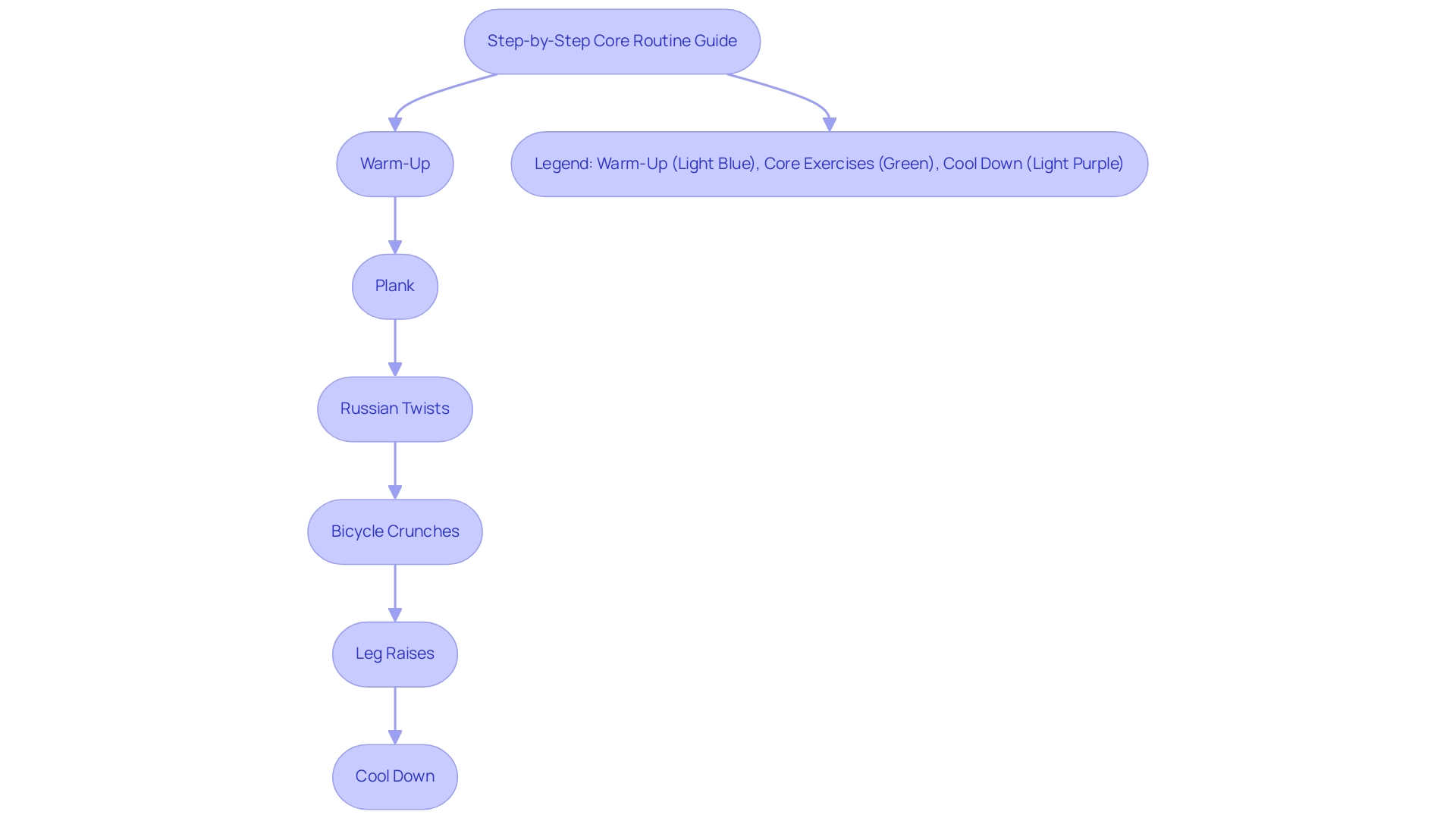
Tips for Staying Motivated
Maintaining motivation can indeed be a challenge, but the following strategies, rooted in personalized coaching principles, will empower you to stay committed to your fitness journey:
- Set Clear Goals: Articulate your objectives for your core workouts, whether it’s enhancing strength, improving posture, or alleviating back pain. By establishing specific, measurable, achievable, relevant, and time-bound (SMART) goals, you create a focused path towards success. As Zender observes, only 51% of companies even strive to create aligned goals, which emphasizes the significance of clear goal-setting not just in health but also in workplace wellness programs.
- Track Your Progress: Utilize a journal or fitness app to document your workouts and monitor your advancements. Witnessing your progress not only reinforces your commitment but also serves as a powerful motivator to keep pushing forward. Research indicates that individuals who monitor their progress are 33% more likely to stick to their fitness programs.
- Find a Workout Companion: Teaming up with a friend can change your fitness regimen into a fun and enjoyable experience. This companionship fosters accountability, allowing you both to uplift each other and celebrate your achievements together. A case study on motivation techniques revealed that social support significantly enhances adherence to exercise routines, especially when faced with challenging goals.
- Mix It Up: Combat monotony by diversifying your exercises. Explore a variety of essential workouts, including Pilates or yoga, which not only keep things engaging but also promote greater flexibility and overall well-being.
- Reward Yourself: Acknowledge your accomplishments, no matter how minor. Treat yourself to something special upon reaching a milestone—be it new workout gear or a soothing massage—as a way to reinforce your dedication.
- Stay Positive: Concentrate on the numerous benefits you’re experiencing, from increased energy levels to an uplifted mood. In moments when motivation dips, recall these positive changes to reignite your enthusiasm. By understanding the impact of sustained goal difficulty on motivation over time, as indicated in recent studies, you can better navigate the ups and downs of your wellness journey.
Combining these strategies with personalized support and guidance from experienced coaches, who utilize evidence-based techniques like cognitive behavioral strategies and motivational interviewing, can lead to lasting lifestyle changes and empower your well-being. As one of our clients, Sarah, shared, "With the help of my coach, I not only achieved my fitness goals but also gained the confidence to maintain them. The personalized approach made all the difference!"
Let’s discuss how we can help you thrive in the modern world while learning from the wisdom of the past. Contact us today to schedule a consultation!
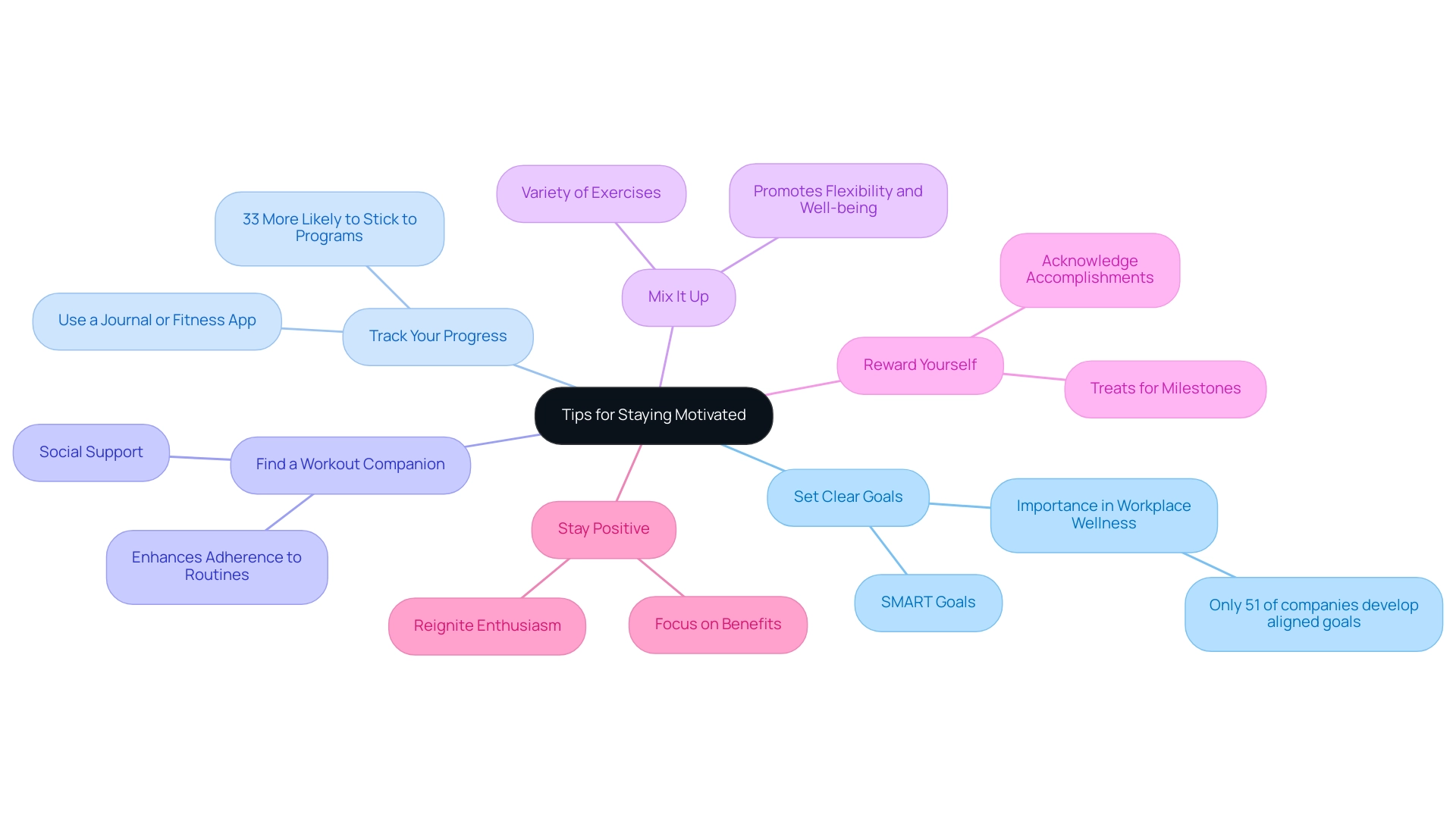
Incorporating Core Exercises into Your Workday
Incorporating a daily core routine into your workday can be both easy and effective. Here are several strategies designed to help you stay active while fulfilling your professional responsibilities:
-
Desk Exercises: Engage in seated leg lifts or seated twists while working at your desk.
These activities need little space while efficiently engaging your abdominal muscles, boosting productivity and decreasing fatigue.
-
Standing Desk: If available, choose a standing desk and include balance exercises such as standing on one leg or doing calf raises to activate your muscles throughout the day.
This not only benefits physical health but also boosts overall motivation.
-
Break Time Workouts: Utilize your breaks for quick abdominal workouts.
Dedicating just five minutes to perform planks or wall sits can be done in any location and yield significant benefits, such as reducing absenteeism and presenteeism.
-
Walking Meetings: Propose walking meetings as an alternative to traditional sit-down sessions.
This encourages physical activity, enhances creativity, and fosters a dynamic work environment, ultimately improving employee engagement.
-
Stretching: Remember to take moments to stretch your central muscles during the day.
Basic stretches can reduce tension and improve flexibility, both of which aid in enhanced strength and emotional well-being.
-
Set Reminders: Utilize reminders or fitness applications to encourage you to take brief activity breaks during your workday, ensuring that you remain committed to your daily core routine.
The advantages of such initiatives are significant; according to a recent report, 94% of brokers observed that many employers invest in wellness incentives. Moreover, research indicates that employees who participate in regular physical activity report feeling more motivated and are less likely to experience burnout.
By emphasizing fundamental activities and promoting a culture of appreciation and wellness, you can greatly improve employee satisfaction and productivity, cultivating a lively, concentrated, and involved workforce.
At Foresight Health Coaching, our tailored wellness programs not only provide employees with valuable tools for a healthier lifestyle but also demonstrate executives' commitment to a loyal and thriving team.
This leads to reduced absenteeism, lower healthcare costs, and ultimately, attracts top talent.
Schedule a consultation with us today to learn how we can support your team's health and well-being!
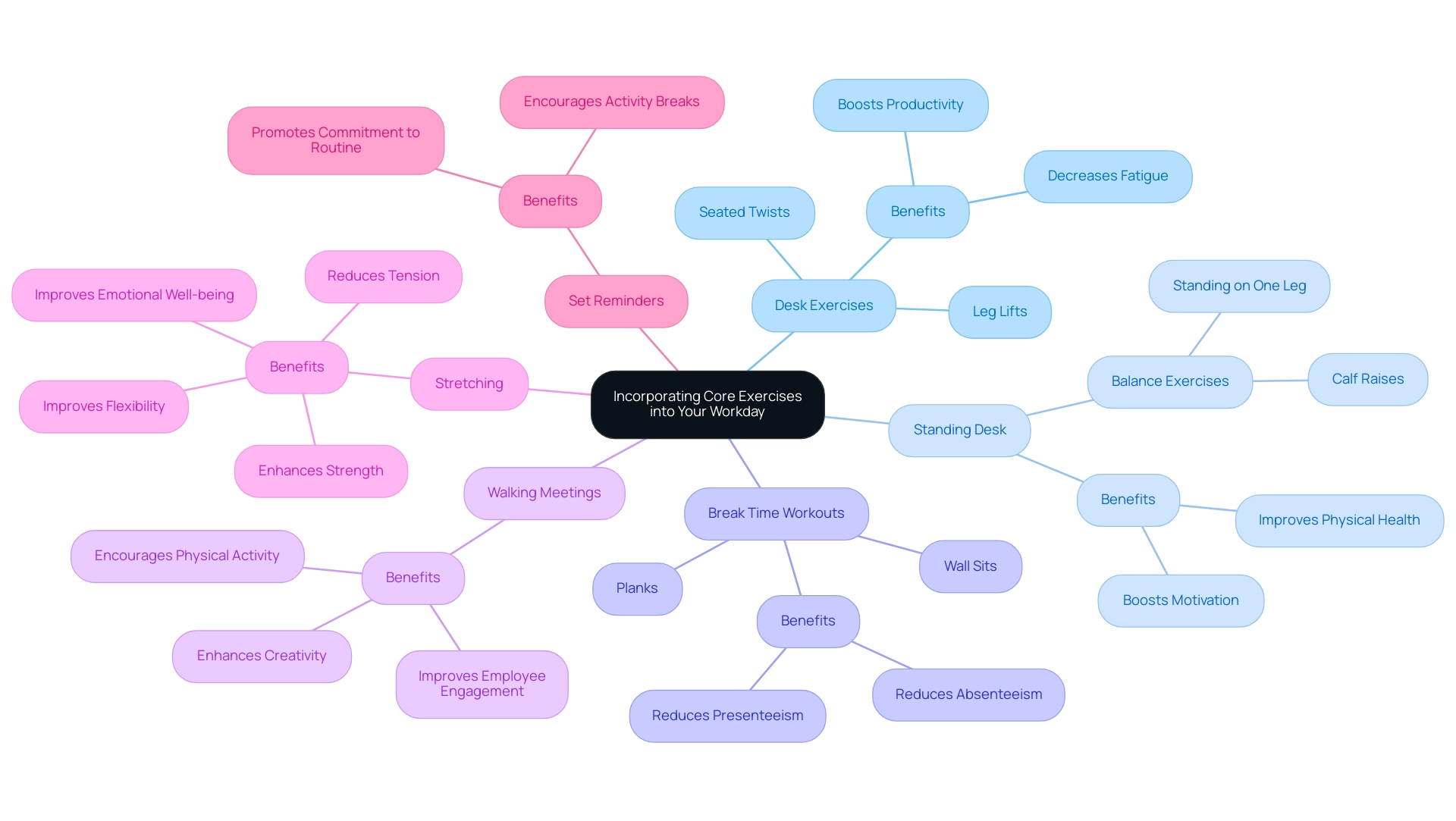
Evaluating Your Progress and Adjusting Your Routine
To ensure that your core routine remains effective and continues to yield results, it's essential to regularly evaluate your progress and make necessary adjustments. Here’s how you can take proactive steps in this journey, supported by the comprehensive health coaching services from Foresight:
- Set Checkpoints: Establish regular intervals, such as every 4-6 weeks, to assess your progress. Use these moments to re-evaluate your goals and the effectiveness of your activities, ensuring they align with your current capabilities and aspirations. This process mirrors our tailored coaching programs designed to adapt to individual needs and workplace dynamics.
- Measure Your Strength: Keep track of metrics such as how long you can hold a plank or the number of repetitions you can perform for each exercise. Documenting these details not only highlights your improvements over time but also boosts motivation as you witness your progress unfold. Our app-based delivery system enables this tracking, making your wellness journey seamless and allowing for community engagement among users.
- Listen to Your Body: Your body is an excellent indicator of how well your regimen is working. Pay attention to how you feel during and after workouts; if you experience pain or discomfort, it may indicate a need to adjust your regimen or consult a health expert for guidance. Our individual coaching services provide that expert support to enhance your experience.
- Reassess Goals: As you make strides, your goals might evolve. Regularly revisit and adjust these objectives to ensure they remain relevant and challenging, pushing you to achieve greater heights. This adaptability is a cornerstone of our personalized programs.
- Seek Feedback: Collaborating with a fitness professional or participating in group classes can provide valuable feedback on your form and technique. This guidance is crucial for maximizing the effectiveness of your practices and reducing the risk of injury, echoing our commitment to wellness workshops that foster community learning. Our corporate memberships also include in-person wellness talks that further enhance this feedback loop.
- Stay Flexible: Embrace the idea of flexibility in your routine. Be open to integrating new exercises or increasing intensity based on your evaluations. This adaptability not only keeps your core workouts fresh but also enhances your engagement and enjoyment in the process, reflecting our holistic approach to health.
As you take these steps, remember that endurance athletes often push themselves too hard, which can diminish the benefits of their workouts. As Hamilton notes, "Endurance athletes in particular are notorious for going too hard on their long-slow training days, which often robs them of that workout’s intended purpose." Additionally, consider the importance of rest intervals during strength training sessions, which should typically be between 3 to 5 minutes to allow for optimal recovery and performance.
Regular evaluation and adjustment allow you to optimize your performance while prioritizing your well-being. With Foresight, you can foster a culture of progress and adaptability, inspiring your team to take charge of their fitness journeys, leading to improved health and morale. Our app not only tracks progress but also connects users with a community, enhancing the overall coaching experience.
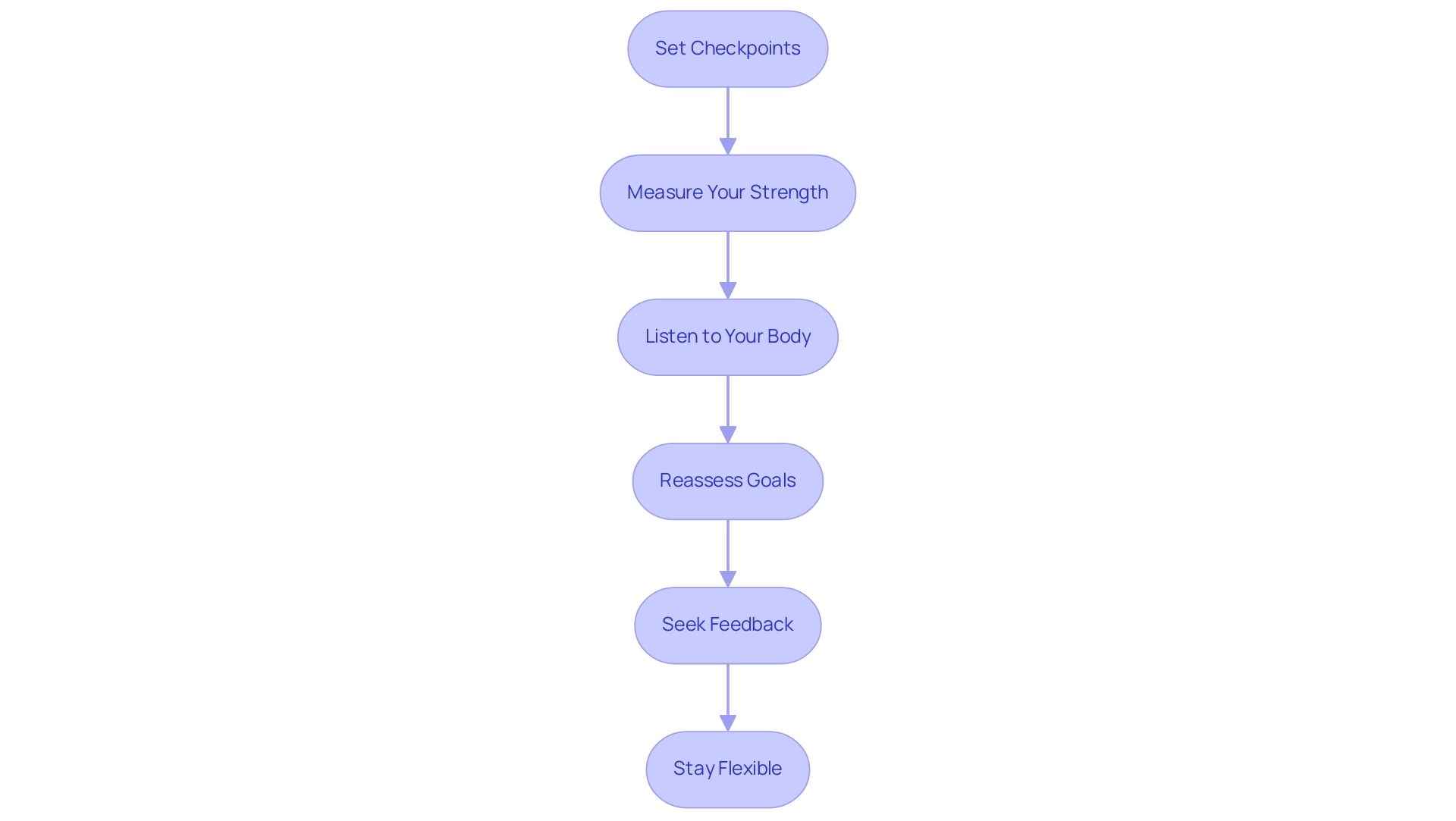
Conclusion
Emphasizing the significance of core strength in the workplace is essential for fostering a culture of well-being and productivity. A daily core routine not only enhances physical health but also supports improved posture, reduced back pain, and increased athletic performance. By integrating personalized coaching and innovative wellness programs, organizations can empower their teams to embark on a transformative journey toward better health, ultimately benefiting both individuals and the workplace as a whole.
Building a structured core routine can be empowering and rewarding. By following a step-by-step approach, including:
- Warm-ups
- Targeted exercises
- Cooldowns
employees can engage in effective workouts that fit seamlessly into their schedules. Staying motivated through goal setting, progress tracking, and social support can further enhance adherence to these routines, ensuring that core strength becomes a priority.
Incorporating core exercises into the workday through:
- Desk workouts
- Standing desks
- Active meetings
transforms mundane tasks into opportunities for fitness. By fostering a culture that values physical activity, organizations not only improve employee satisfaction but also reduce absenteeism and healthcare costs. Regularly evaluating progress and adjusting routines ensures that the focus on core strength remains dynamic and effective, allowing for continuous improvement and engagement.
Ultimately, the commitment to core strength is an investment in the overall health and productivity of the workforce. By prioritizing wellness initiatives and providing the necessary tools and support, organizations can create a thriving environment where employees feel empowered to take charge of their well-being. Now is the time to embrace these practices and witness the profound impact they can have on both individual health and collective workplace performance.
Frequently Asked Questions
Why is incorporating a daily core routine important?
A daily core routine is crucial for overall health and performance enhancement, as it stabilizes the body, improves posture, and alleviates back pain, which is common in sedentary jobs.
How does core strength benefit athletic performance?
Research indicates that fundamental strength improves athletic performance by enhancing balance and stability, as demonstrated in studies on teenage male handball athletes.
What features does the wellness coaching app offer to support core routines?
The app provides personalized workouts, guided nutrition, a movement catalog of over 350 exercises, bi-weekly group calls, and an accountability hub to help users achieve their health goals.
How can a strong core reduce injury risk?
A well-developed core significantly lowers the risk of injuries, particularly in the lower back, making it essential for maintaining an active lifestyle.
What are the steps to establish a daily core routine?
The steps include warming up, performing planks, Russian twists, bicycle crunches, leg raises, and cooling down, aiming for 4-5 sessions per week.
How long should each exercise in the core routine be held or performed?
Start with holding the plank for 20-30 seconds, and aim for 10-15 repetitions for the other exercises, gradually increasing intensity and duration as strength improves.
What does research say about the effectiveness of foundational workouts?
Research shows that foundational workouts significantly enhance stability and strength, with even a five-minute daily routine yielding notable improvements over time.
What is the connection between the MIND diet and core strength?
Incorporating foundational strength activities through the app can improve overall health, including memory and cognitive abilities, as suggested by the MIND diet's benefits.

